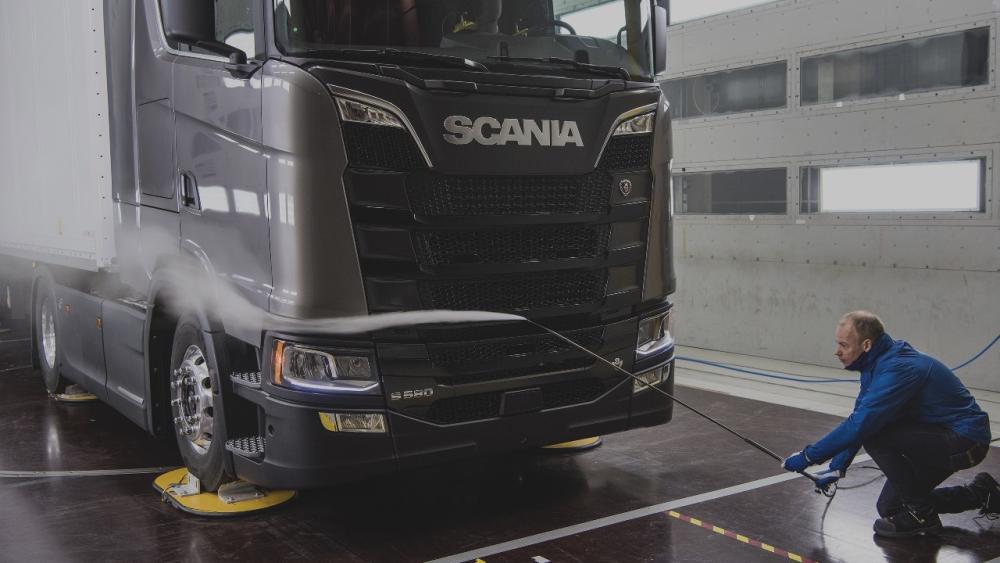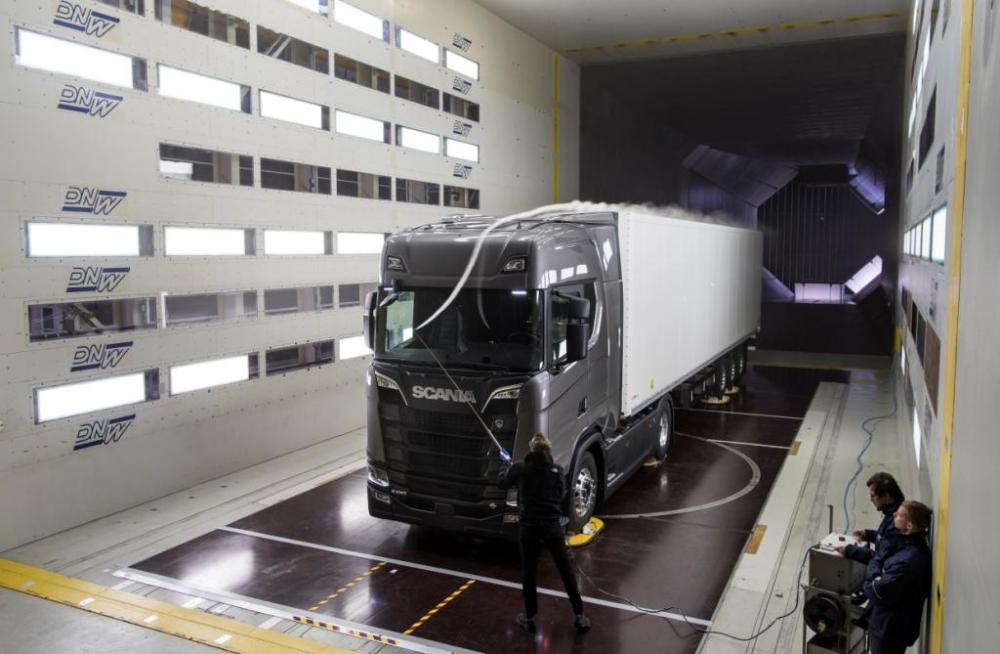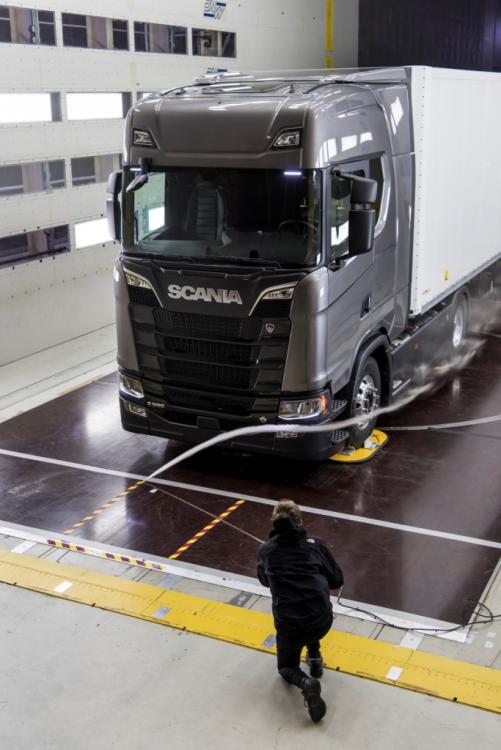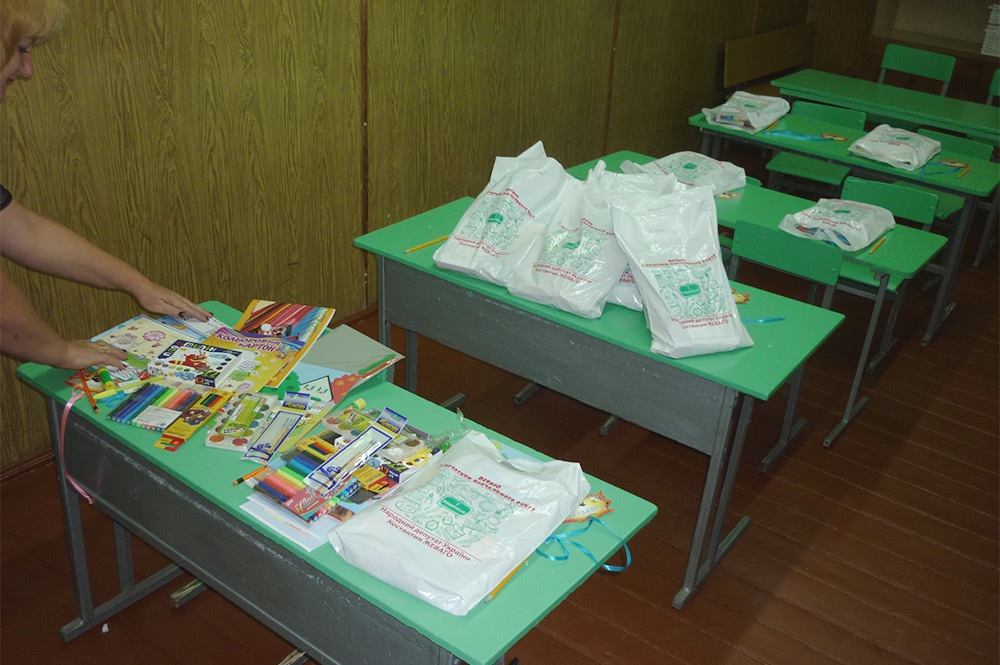
kscarbel2
Moderator-
Posts
17,893 -
Joined
-
Days Won
86
Content Type
Profiles
Forums
Gallery
Events
Blogs
BMT Wiki
Collections
Store
Everything posted by kscarbel2
-
It’s time for an 'adult conversation' on longer, heavier trucks
kscarbel2 replied to kscarbel2's topic in Trucking News
I'm still struggling at how to interpret this. I post "all" the U.S. truck industry news and most of the significant global. I don't write it. i strive to provide a one-stop news source for the truck industry. i strive to meet everyone's interests. By presenting the face of the trucking industry, including a global perspective, I strive to enhance, and extend, everyone's understanding, as the world has become a much smaller place. -
Hyundai Xcient - Your reliable business partner
kscarbel2 replied to kscarbel2's topic in Other Truck Makes
Service for the Xcient's optional ZF AS Tronic AMT is a non event. -
Mercedes-Benz Trucks and Krone team up to cut emissions
kscarbel2 replied to kscarbel2's topic in Trucking News
Here's a new article on the subject. http://www.bigmacktrucks.com/topic/46938-blown-away/ -
Scania Group Press Release / September 19, 2016 Aerodynamic characteristics were a key focus for Scania as it developed its new generation of trucks. The record-low levels of air drag in the range significantly reduce both fuel consumption and environmental impacts. Vehicles with an aerodynamic shape use less fuel. Air flows easily over them and less energy is required to propel them forward. Even small changes in design and shape can make a big difference. In 1991, Scania Streamline was launched, a truck and cab that set new industry standards for both design and fuel consumption. The concept was further refined in 2013 with the release of a completely new Streamline, which in turn has been the reference vehicle as the aerodynamics for Scania’s latest generation of trucks have been tested. In Europe’s biggest wind tunnel – located north of Amsterdam, among the cows and wind farms on the coast of the Netherlands – a Scania team is working against the clock. With time in the high-tech facility strictly limited, conducting as many tests as possible in the time available is crucial. “This wind tunnel in the Netherlands is the only facility in Europe where it’s possible to test the aerodynamic performance of full-sized trucks with trailers,” says David Söderblom, Senior Engineer Aerodynamics and test leader for the all-important wind-tunnel tests. Improved aerodynamics, with a view to obtaining better fuel economy, is one of the main innovations in the new generation of trucks. And while the tests in the wind tunnel are costly, the work is being carried out for the sake of customers. Per Elofsson is Senior Technical Manager Aerodynamics and responsible for the aerodynamic qualities and characteristics of the new generation of trucks. He explains that as early as 2006 a basic study was conducted, which was then followed by styling proposals and pre-studies. Now, 10 years on, the last tests are being conducted in the wind tunnel. “Numerous aerodynamic improvements work together to provide significant fuel savings compared with our existing trucks – vehicles that are already considered industry benchmarks in terms of fuel consumption,” says Elofsson, pointing out the most important aerodynamic improvements. “A key factor is the new optimised corners of the cab. But we have also modified the roof and increased the number of performance steps for things like air deflectors, the shape of the bumper, and wheel arches. We’ve also done a lot of work on the underside of the vehicle. We have more panels and inner seals and side air deflectors with a lengthened lower edge to reduce the gap between the side skirts and the air deflector. It all combines to produce what we believe is the most aerodynamic truck on the market.” Good aerodynamics also contributes to reducing the noise level, both inside and outside the truck. Ragnar Glav is Scania’s Technical Manager Acoustics and responsible for the sound environment in the new Scania. The wind tunnel allows him to conduct aero-acoustic measurements in a controlled and quiet environment. “I work with the sound environment within the cab, partly to ensure a good working environment but also to communicate Scania’s character,” he says. “To evaluate the acoustic characteristics of the vehicle we conduct measurements both on the road and in wind tunnels.” “Our goal is always that the driver should feel he or she is driving a premium product. This should also be reflected in the sound quality.” Reduced air drag saves fuel The new generation of Scania trucks has been designed to provide the best aerodynamic performance ever, and the trucks include a range of new, innovative features for reducing drag. Scania now offers three adjustable air deflectors to enhance alignment between the cab and the roofs of trailers. Customers can adjust the alignment themselves. Other drag-reducing features on the cab are: integrated auxiliary lights and end-marker lamps placed just under the roof and windscreen – an external sun visor is not needed smaller gaps and tolerances between all components and lights, with the windscreen mounted flush to the cab optimally-shaped rear view mirrors. .
-
Cleveland company acquires former Navistar plant site Indianapolis Business Journal / September 19, 2016 The former Navistar plant on Indianapolis’ east side has been sold, but the new owner says he’s not certain yet what his company will do with the property. The Brookville Road site, which includes about 1.6 million square feet on about 90 acres, formerly housed a Navistar International Corp. engine plant and foundry. The engine plant ceased operations in 2009 after about seven decades of production at the site, and the foundry shut down in June 2015. Cleveland-based Park Corp. purchased the site from Navistar last month. Terms of the deal were not disclosed, though in a recent filing with the U.S. Securities and Exchange Commission Navistar described the sales price as “an immaterial amount” to the company. The property's value was accessed at at about $8.5 million in 2015, but that was lowered to about $3.8 million this year. The huge east-side facility employed as many as 1,650 workers in 2005, but began mass layoffs amid the recession as the auto market tanked. The engine-plant closure cost about 700 employees their jobs. About 180 workers lost their jobs when the foundry shut down. Navistar is still doing some wind-down activities at the plant but that work should be finished by the end of this month, said Raymond Park, founder and chairman of Park Corp. Park, 90, founded his company in 1946. It specializes in purchasing assets—particularly industrial sites—to refurbish and lease. Park said his family-owned company has about 30 million to 40 million in real estate holdings in several states, including Ohio, Pennsylvania, West Virginia, Minnesota, Texas, California and Oregon. Park said his typically purchases properties before it decides exactly how to repurpose them—and this is also the case with the Navistar site. “Very seldom do we buy a plant and know exactly what we’re going to do with it,” Park said. “We go down the best road possible.” Park said his company’s initial strategy for the Navistar site will be to try and find a new tenant or tenants for the foundry. “We may be unsuccessful in doing that. It may be successful,” Park said. A single tenant might want to occupy the entire property, or it might end up being split among multiple tenants. Whoever ends up at the site, Park said his company intends to hold the property for the long term. “We’re not in the business of buying and selling. We’re in the business of buying and fixing up and leasing,” Park said. It’s a strategy Park has used with success in other locations. In 1977, Park Corp. purchased a former military bomber and tank plant in Cleveland and redeveloped it into the International Exposition Center, or I-X Center. The facility occupies 2.2 million square feet and is located next to Cleveland Hopkins International Airport. Park Corp. sold the I-X Center to the city of Cleveland and now leases the space back from the city. Park Corp.’s offices are also housed in this facility. Another long-term Park Corp. holding is an auto stamping plant in South Charleston, West Virginia. When a former tenant ceased operations at the site in 2006, Park Corp. invested millions of dollars in the property and equipment with the goal of finding a new tenant to restart the site. Park landed Spanish company Gestamp Automocion, and stamping operations resumed at the site in 2012. The first order of business for the old Navistar site will be cleanup. Workers have already started cleaning the foundry area. By the end of the year, Park plans to have an auction to get rid of excess machinery and equipment. “Six months from now, we’ll know a lot more than we do now,” Park said. It’s also premature to know if the project will receive any economic incentives. Todd Cook, senior project director for Indianapolis Economic Development at the Indy Chamber, said local incentive offers could come after Park Corp. secures a tenant for the site. The level of incentives would depend on how many employees end up working at the facility. “We’ll work with them as appropriate,” Cook said. For most of its 70-year-plus history, the local Navistar plant operated under the name International Harvester and built a range of products, from farm implements to refrigerators. In its later years, it made only diesel engines—a booming business before the Great Recession set in. In 2005, the engine plant had 1,100 union employees working two shifts, rolling out 280,000 engines annually. The foundry employed another 550 workers. That year, Navistar invested more than $300 million to upgrade the facility to meet new federal Environmental Protection Agency diesel guidelines. Its main customer was Ford Motor Co., which bought the engines for its F-series pickup trucks.
-
It’s time for an 'adult conversation' on longer, heavier trucks
kscarbel2 replied to kscarbel2's topic in Trucking News
President Eisenhower had "vision" when he imagined and built America's interstate system. At its inception, it was a benchmark for the world. However, the country has done a deplorable job since then maintaining and expanding it. The government allowed a massive asset to wither away. And now, it's poor condition arguably prevents us from using more efficient truck solutions. We pour away billions and billions overseas, and then hear there's inadequate funding to take care of the home front. -
As many here can recall, Chapel Hill, North Carolina-based Kenan was once an all-Mack fleet.
-
Transport Topics / September 19, 2016 Kenan Advantage Group said it has acquired Agri-Carriers Group Inc., a company based in Jacksonville, Illinois, that specializes in hauling food-grade products in bulk, including soybean oils, yeast, vinegar and corn syrup, used to manufacture food products in the United States. The company also provides refrigerated and dedicated van transportation services. Terms of the transaction were not disclosed. The deal doubles the size of Kenan Advantage Group’s food transportation business, according to executives at the North Canton, Ohio-based firm. The Agri-Carriers Group consists of two trucking companies: Landes Trucking Inc. in Jacksonville, Illinois, and Charles G. Lawson Trucking Inc. in Hope Hull, Alabama. The two companies operate a combined fleet of 250 tractors and 425 trailers, employ 375 drivers and office workers and operate five terminals and four food-grade tank washing stations. “By partnering with this ‘best-in-class’ organization, we have doubled the size of our food transportation business,” said Dennis Nash, CEO of KAG. “We are committed to the success of this growing platform. Their expertise and scale in this space complements our legacy business and firmly establishes KAG as one of the leading food-grade carriers in the U.S.” Roger Ross, CEO of ACG, said the “alignment of core values, operational structure and strategic plans made our decision to join KAG extremely compelling.” “By combining our talented employees, fleet and terminal locations, we expect to further enhance services to our collective customers while expanding our customer base and food-grade product service lines,” he said. “This will also provide additional career opportunities for our employees.” Kenan Advantage Group ranks No. 21 on Transport Topics’ Top 100 For-Hire Carriers list with 2015 revenue of $1.5 billion and is the largest carrier in the tank/bulk sector in North America. The company provides a variety of transportation services, including fuel delivery, distribution of chemicals, industrial gases, and ethanol and logistics services, including transportation management, fuel storage and transloading. The last major acquisition by KAG was the purchase in 2013 of RTL-Westcan, a bulk hauler operating in western and northern Canada. Prior to the latest acquisition, KAG operated 4,458 company-owned tractors and 1,875 owner-operator and lease-to-own tractors, along with 9,491 trailers. More acquisitions of food-grade bulk carriers could be in the offing, according to Charlie Delacey, vice president of corporate development for KAG. “The acquisition of ACG is a strong strategic fit that demonstrates our focus on the food-grade industry,” Delacey said. “We will continue to pursue additional growth opportunities in the sector as we further expand our leadership position in food-grade transportation.”
-
Volvo Shows Off SuperTruck Entry to Energy Secretary Ernest Moniz
kscarbel2 replied to kscarbel2's topic in Trucking News
Making a SuperTruck: So that's how they did it Fleet Owner / September 18, 2016 Slide Show - http://fleetowner.com/technology/making-supertruck-so-thats-how-they-did-it#slide-0-field_images-200951 -
Heavy Duty Trucking / September 19, 2016 Sales of Ford’s medium-duty F-650 and F-750 trucks have increased 59% year-over-year through August, the best year-to-date sales through August since 1997, according to Ford. So far this year, Ford has sold 10,160 F-650 and F-750s, including Regular Cab, SuperCab and Crew Cab body styles as well as straight-frame, kick-up frame Pro Loader and a new dedicated tractor model for heavy-towing applications. “We’re seeing growing interest in the new tractor from beverage and hauling fleets,” said Kevin Koester, Ford medium-duty truck and Super Duty fleet marketing manager. “Giving our customers the choice of two exclusive powertrains, available across all body styles and designed specifically for the unique needs of the vocational truck market, has really helped drive sales of our new trucks.” ord offers a gasoline engine option for both the F-650 and F-750 with its 6.8-liter V-10 with 320 horsepower and 460 lb.-ft. of torque, a unique offering in the medium-duty truck segment according to Ford. The engine can be factory-prepped for converting to compressed natural gas or liquid propane gas alternative fuels. Ford also offers a 6.7-liter Power Stroke V-8 turbo diesel engine with 270 horsepower and 675 lb.-ft. of torque with available higher output options. The engines are paired with the company’s TorqShift six-speed automatic transmission. “Towing and rental customers have embraced the gas engine, and others are looking at this powertrain for more severe service applications,” Koester says. “Our diesel customers are praising the quietness of the 6.7-liter Power Stroke diesel engine.”
-
Transport Topics / September 19, 2016 Volvo Trucks North America (VTNA) is laying off 143 employees effective Sept. 19 at its Volvo Powertrain manufacturing facility in Hagerstown, Maryland, the company announced. “We regret having to take this action, but it’s a necessary step in our continued adaptation to market conditions, said VTNA spokesman John Mies. The layoff follows one in the first quarter, when VTNA laid off 138 Hagerstown employees. Earlier this spring, VTNA introduced its latest engines and related enhancements at the factory. The plant, built in 1961 by Mack Trucks, Inc., assembles engines and transmissions for Volvo and Mack Trucks, as well as Mack axles. Mack and VTNA are units of Sweden-based Volvo Group.
-
I plan to purchase both a global Ranger and Everest (rebadged as Bronco) after US production begins. However, this all hinges on Ford not destroying what is now a superb product, when they reconfigure them for the US market. Ford has a long history of doing so, from the superb Mk1 and Mk2 Capri to Merkur and the Kuga (Escape).
-
SAF Offers $495 Million for Haldex in Truck-Parts Combination
kscarbel2 replied to kscarbel2's topic in Trucking News
Haldex picks ZF's $647 million bid over higher Knorr-Bremse offer Reuters / September 19, 2016 Swedish braking systems maker Haldex has backed a 5.53 billion crown ($647 million) takeover offer from German car parts firm ZF Friedrichshafen, even though it is less than a rival bid from Germany's Knorr-Bremse. Haldex said today its board had unanimously recommended shareholders accept ZF's offer because there was greater certainty it would go through. ZF has received clearances from antitrust regulators, while Knorr-Bremse's bid ran the risk of not clearing all regulatory hurdles, Haldex said. Knorr-Bremse, which makes braking systems for rail and commercial vehicles, last week raised its offer to 125 crowns ($5.17) per share, while ZF's upped its bid to 120 crowns, corresponding to 5.53 billion crowns and 5.29 billion crowns, respectively. Several German car parts makers have been looking to buy Haldex, keen on its expertise in brakes for trailers in particular as they seek to develop integrated autonomous driving systems for commercial vehicles. "ZF has announced that it has received all necessary regulatory approvals and clearances, whereas there is a very real and material risk that Knorr-Bremse's offer would fail to complete," Haldex's board said in a statement. ZF, which acquired U.S.-based TRW in 2015 for $12.4 billion, makes transmissions and a range of other automotive components. Haldex's board had previously warned that overlaps with Knorr-Bremse's business would trigger lengthy antitrust reviews. Knorr-Bremse CEO Klaus Deller said on Friday he expected to get the green light from regulators in a "reasonable time" but would not be drawn on which assets might have to be sold or when a deal could close.. A spokesman for ZF said today the recommendation showed its offer was "better overall and quicker to realize." Shareholders have until Oct. 3 to tender their shares to the German group. Knorr-Bremse said it had taken note of Haldex's announcement and stood by its offer but was planning to comment in more detail once it had reviewed the statement in depth. It reiterated its full offer was slated to be published on Sept. 26 and the acceptance period for Haldex shareholders would run until about Dec. 5. -
Ford tries to fire back at Trump, citing Ohio-made trucks Bloomberg / September 19, 2016 Ford Motor Co., attempting to push back against criticism by Republican presidential candidate Donald Trump for moving work to Mexico, is highlighting its booming business in big trucks after shifting production to an Ohio factory from south of the border. The automaker has sold 10,160 of its F-650 and F-750 trucks this year through August, up 59 percent from the same period in 2015 and the highest sales of those models since 1997, the automaker said in a statement today. The big trucks are used as commercial vehicles, including beer haulers and tow, moving and dump trucks. Ford is firing back at Trump, who last week called the automaker “a disgrace” after CEO Mark Fields told investors that the second-largest U.S. automaker is moving North American small-car production to Mexico, where labor costs are lower than in the U.S. After Trump threatened to levy a 35 percent tariff on Ford’s Mexican-built cars, Fields said the company is “absolutely not” cutting U.S. jobs to move small-car operations south because the Michigan plant currently building them will manufacture other models. ‘American jobs’ “It’s really unfortunate when politics get in the way of the facts,” Fields said in a September 15 interview on CNN. “And the facts are, Ford’s investment in the U.S. and commitment to American jobs has never been stronger. I mean, we’ve created more than 28,000 jobs in the U.S. in the last five years.” Ford began producing the F-650 and F-750 at its assembly plant near Cleveland a year ago after the company spent $168 million converting the factory from building Econoline vans. They previously had been produced in Mexico in a joint venture with Navistar International Corp. known as Blue Diamond Trucking Co., which disbanded in 2014. The automaker now builds its full-size van, known as the Transit, at an assembly plant in Claycomo, Mo. The company is focusing on building high-margin trucks, vans and SUVs in the U.S., where labor costs are more expensive than in Mexico. Ford derives most of its profit from its F-series truck line, Morgan Stanley has said. And the largest vehicles in the line generate the biggest return, according to analysts. By going it alone in the big-truck market, Ford no longer has to share profits with Navistar. After parting with Navistar, Ford redesigned the F-650 and F-750 to offer them in a variety of body styles and with either gasoline or diesel engines. General Motors exited that segment of the truck market following its 2009 government-backed bankruptcy. “We’re seeing growing interest in the new tractor from beverage and hauling fleets,” Kevin Koester, Ford’s marketing manager for the models, said in a statement. “Towing and rental customers have embraced the gas engine.”
-
Associated Press / September 19, 2016 Five armed Afghan men in an SUV were arrested Sunday night around 9:30 p.m. in connection with the New York explosion, following a traffic stop conducted by the FBI and NYPD on the Belt Parkway near the Verrazano–Narrows Bridge. The men were believed to be headed out of town or on their way to the airport. .
-
It’s time for an 'adult conversation' on longer, heavier trucks
kscarbel2 replied to kscarbel2's topic in Trucking News
Back in 2001, I advised senior Ford management to bring the Transit to the US. They resisted, arguing that the Transit wasn't suitable. They said Americans like to tow with their vans, whereas the Transit wasn't engineering for towing because nobody tows with Transits in the global market. Still, I argued the Transit in every other way was 20 years ahead of the Econoline in overall form and function. They agreed, but decided to postpone a US launch. In Europe, the Transit is available in rear-wheel drive, front-wheel drive or all-wheel drive. Like all global market light vehicles, the US gets the decontented version, because we demand a low price. -
Mercedes-Benz Trucks and Krone team up to cut emissions
kscarbel2 replied to kscarbel2's topic in Trucking News
In theory, the European COE "has" a tougher struggle to become aerodynamic than a conventional. And that is why European regulations are going to change, so as to allow a slightly longer cab in the front for enhanced aerodynamics. However, having said that, when you observe the next generation Scania in the wind tunnel, you can see the truckmaker has achieved virtual perfection in aerodynamics. Frankly speaking, Scania has some brilliant engineers with a life-long passion for truck design. I really wish you were attending the global IAA show in Hannover. It's good for one's head (eye-opening) to get out of town (or country) and see what's going on around the world. . -
It’s time for an 'adult conversation' on longer, heavier trucks
kscarbel2 replied to kscarbel2's topic in Trucking News
Paul my friend, I'm not lumping together my thoughts on global trucking trends with anything else. Cars, motorcycles, education, government, unions, general intelligence and health care aren't on my mind. Although my thoughts are global in scope, I'll be the first to criticize the dysfunctional European Union. You can blame global big business for its creation, their scheme for enhancing profitability in Europe. -
"The Mack Dealer assumes responsibility for min buy, collect freight, non-cancellable and not eligible for return" Absolutely shocking. Volvo's Mack brand parts policies are not consistent with American values.
-
It’s time for an 'adult conversation' on longer, heavier trucks
kscarbel2 replied to kscarbel2's topic in Trucking News
Relax my friend. Nobody said the US is dumb and stupid. We talking about truck design, i.e. tractors and trailers. The US does have a unique go-it-alone tone, that's undeniable. I myself wish we had one set of emissions standards for the entire world, rather than U.S. standards, and the Euro standards that most of the world uses. We could could it the "Global Emissions Standards". Limited to small trailers and 80,000lb GCW limits, we aren't operating as efficiently as we could or should. I will bash the United States EPA for forcing EPA2004 and EPA2007 down our throats before the technology was mature for US market trucks. It costs American truck operators millions of dollars. Those trucks are nothing more than rolling advanced science experiments. The engine compartments were so hot, I watched windshield washer reservoirs melting under the hoods of Mack Visions. Nobody ever said that Americans are "dumb" for not driving COEs. People expressed their opinion. I myself appreciate the added efficiency, serviceability and visibility of COEs. Mack sold thousands and thousands of F-models, Cruise-Liners and Ultra-Liners for those very reasons. If you want maximum load capacity while keeping overall length in check, the COE has a strong argument. -
It’s time for an 'adult conversation' on longer, heavier trucks
kscarbel2 replied to kscarbel2's topic in Trucking News
C'mon Paul, we're talking about truck design, and trailers..................not any of the other you mention. -
It’s time for an 'adult conversation' on longer, heavier trucks
kscarbel2 replied to kscarbel2's topic in Trucking News
I know Paul, I know. But old habits die hard. At one time the benchmark for the world, the US truck market today is behind the curve. -
It’s time for an 'adult conversation' on longer, heavier trucks
kscarbel2 replied to kscarbel2's topic in Trucking News
Curtain sided trailer usage is extremely limited in the US, versus Europe and Australia where they are mainstream. -
Volvo has a non-returnable parts policy? That's the most absurd thing I ever heard. I thought such a policy in the United States by auto and truck makers was still illegal. The policy of the former Mack Trucks was, any part still packaged and saleable as new goods could be returned.
-
KrAZ Trucks Press Release / September 1, 2016 Today, on the 1st of September, on the occasion of Knowledge Day, KrAZ truck in conjunction with the Ukrainian government donated school supplies to underprivileged schoolchildren in the Molodyozhniy district. Almost seven hundred gift bags filled with supplies for studies were presented to the children after the first bell. The parents expressed their appreciation for the paints, notebooks, pencils, felt pens, colored paper and many other stationery items donated to their children for learning activities. Teachers and schoolmasters of the Molodyozhniy district also expressed their gratitude. Schoolmistress of the school No 17 Mrs.Valentina Marchenko said: “In our school alone, 124 first grade schoolchildren received stationery items required for learning activities. As for the whole school district, this number comes closer to 1,000. We sincerely thank our local government and KrAZ Trucks for help and support. In this difficult period for our country, companies, institutions, and parents, only such support can help us preserve our values, and we are happy to have such responsible helpers”. Pupils of the school No 31 had another present. The local government and KrAZ Trucks invested over UAH 200,000 to provide the school with a new outdoor sports ground complete with all the necessary equipment. KrAZ Trucks pays special attention to children realizing that, to move forward, young, talented and enterprising children are the key to our future. We are glad to welcome young additions into our family. They are worthy of taking over from today’s workers, and will continue to build excellent trucks in the KrAZ tradition. .
BigMackTrucks.com
BigMackTrucks.com is a support forum for antique, classic and modern Mack Trucks! The forum is owned and maintained by Watt's Truck Center, Inc. an independent, full service Mack dealer. The forums are not affiliated with Mack Trucks, Inc.
Our Vendors and Advertisers
Thank you for your support!









